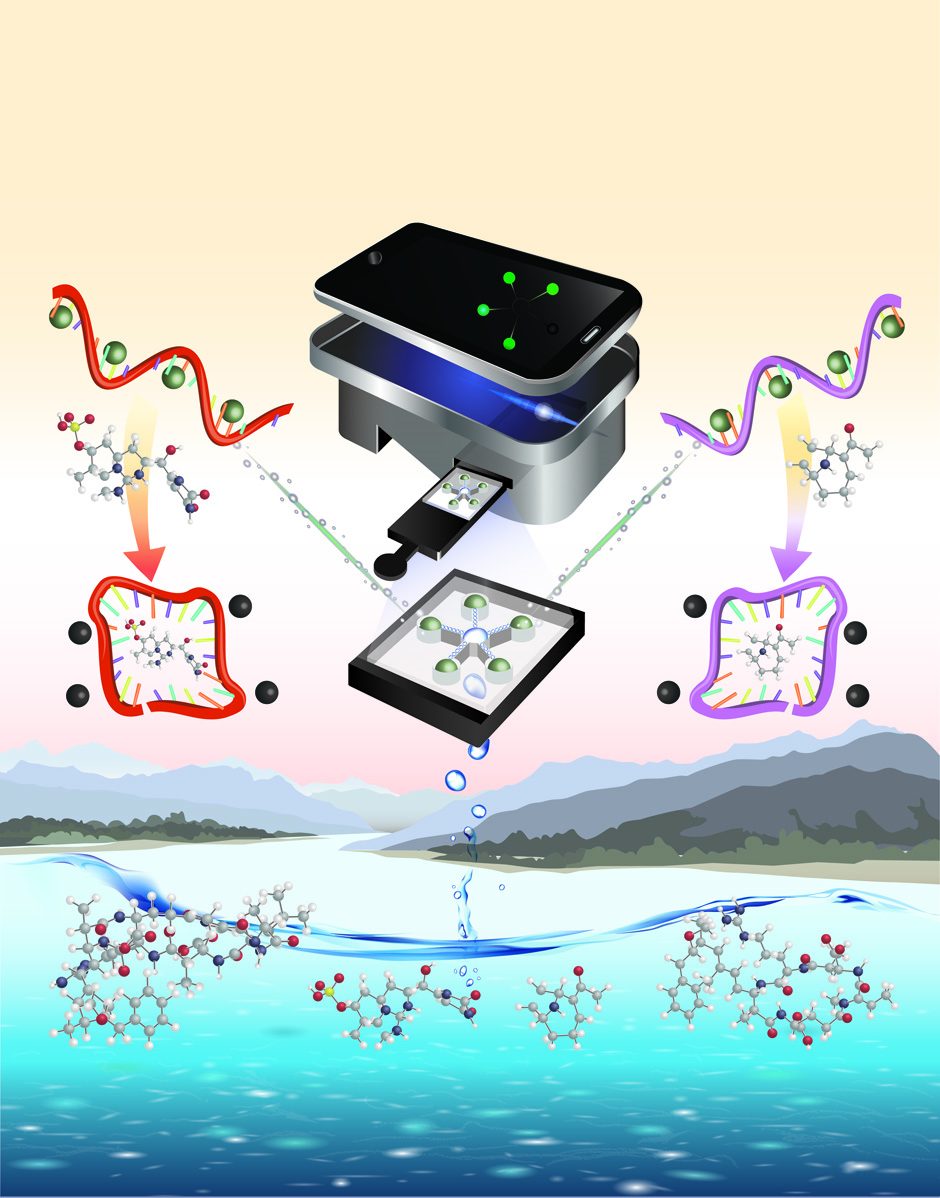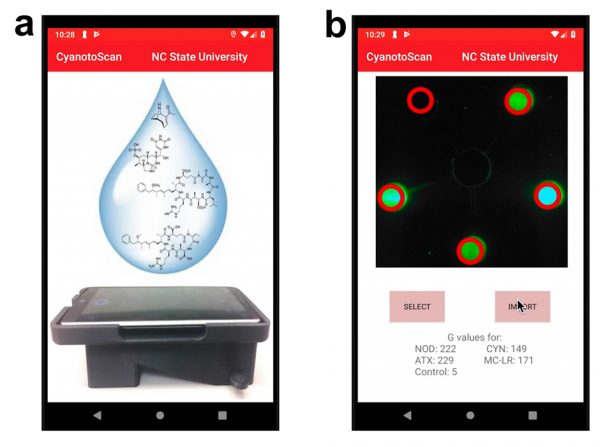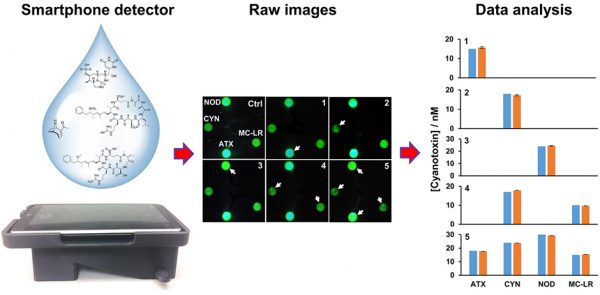Handheld Cyanotoxin Detection Technology Prototype

A graphic representation of the technology. (Credit: Li, Zheng et al, 2019)
In the battle against harmful algal blooms (HABs), time is important. The need for laboratory equipment and testing is a serious challenge for water managers. This issue caught the eye of Qingshan Wei, an assistant professor of chemical and biomolecular engineering at North Carolina State University.
“Our research group is interested in developing low-cost sensors,” Wei told EM. “Recently we have been developing sensors for environmental monitoring, and cyanotoxins came to our attention.”
Cyanobacteria, which generate HABs, are becoming a challenge across the US. They are a very serious problem in North Carolina, in part due to the weather.
“Every year on average we have six or eight blooms, and those blooms release toxic chemicals,” explains Dr. Wei. “They have very severe health implications such as brain damage. So far, the standard detection methods still rely on laboratory technology, such as using mass spectrometry to quantify the cyanobacteria.”
Those methods are very accurate and sensitive, but they also require expensive equipment, and both a laboratory setting and qualified personnel to execute the necessary tasks.
“We thought, maybe people will appreciate a portable technology that enables onsite detection so they can immediately evaluate that quality of the water in the environment and try to guide their daily activities,” Dr. Wei describes. “For example, a test to determine whether you can swim or fish. That was our motivation.”
Obviously one of the problems with this kind of project is size and scalability. The team is still approaching this challenge.

Screenshots of the smartphone app. (a) Welcome page (b) digital analysis (Credit: Li, Zheng et al, 2019)
“Currently I would say this is still our first step because it’s still in the prototype stage,” details Dr. Wei. “We have demonstrated that the unit performs under ideal conditions. Next, we will conduct more field testing and further evaluate the performance under real conditions.”
The team also plans to push the technology out to the broader scientific and water management communities to gauge interest.
“That way we can also potentially achieve more collaborations, further improve this technology, and perhaps get more funding support to develop new technologies,” adds Dr. Wei.
Detecting cyanotoxins with a cell phone
It’s one thing to make a proof of concept work in a lab, but this kind of real-time testing under countless real-world conditions is much tougher to achieve.
“One challenge is getting a sample matrix, but another is the sensitivity,” remarks Dr. Wei. “In this first paper, we reported a sensitivity level that is suitable for recreational water testing, because our interest in the cyanotoxin area is spurred in part by the recent regulation from the EPA.”
Those guidelines established two regulatory concentrations for two of the cyanotoxins in question. However, for the other two, there are still no guidelines. “This means the entire field is to try to establish some criteria,” states Dr. Wei.
However, this isn’t the end of the sensitivity issue.
“Our current sensitivity level can meet those two recently published guidelines for environmental water, but those criteria are not for drinking water,” clarifies Dr. Wei. “WHO’s drinking water guidelines are even lower, which means we still have some work to do to further improve the sensitivity for our sensor technology. Eventually, if we can use these portable sensors to quantify the quality of drinking water, I think that that will be even more impactful.”
Dr. Wei does think that may be possible but recognizes that the team may have to modify their current sensor design to achieve that goal.
“Right now, our sensor is based on an aptamer sequence,” comments Dr. Wei. “These are just single strands of DNA that other research groups have reported can specifically bind to particular types of cyanotoxins. We used a few of those as binding agents, and constructed them into a specific fluorescent assay.”
This way the team can monitor the fluorescent signal change to quantify the cyanotoxin concentration.
“We will probably modify it somewhat so we can further improve the detection sensitivity,” Dr. Wei says. “We can also improve our cell phone reader, to make the device more sensitive, and detect at even lower concentrations. That will be our immediate next step.”
As it stands now, to use the prototype, all that is necessary is the custom chip, the reader, a smartphone, and five minutes—excluding the phone, the reader costs about $70.00 to make.

How the application and detector work. (Credit: Li, Zheng et al, 2019)
“That’s the overall goal to achieve: a single low-cost, portable system that can deliver the quality of measurement you can achieve in a standard laboratory,” confirms Dr. Wei. “We 3D-print these devices in our own lab. We also created a very simple, disposable microfluidic chip, and eventually, we will be able to load the chemical reagents into the chip. We dry all the reagents, prepare the chip, and deliver the chip to the user.”
At that point, the user will just add a small drop from a water sample and scan the signals with the phone. Eventually, any field scientist user can monitor a lake using the device in a customized way, looking for the toxins that put their body of water at risk.
“That’s a future vision we are working to achieve,” Dr. Wei explains. “Eventually, if the technology can be commercialized, users would order an attachment, and it would come with a customized chip, depending on the target you want to detect. By changing some of the binding sequences, users can detect beyond those four toxins we already tested on the same chip.”
The team also did a very primitive study on creating a smartphone app.
“Basically, after you capture the image, the cell phone can actually help process the image and return some quantification results on the screen immediately,” describes Dr. Wei. “Another benefit of using a cell phone is that you can store the data in case you don’t have access to a computer or internet connectivity and transmit it later.”
Meanwhile, the team continues to work on the technology.
“We tried to explore the possibilities where we could. We wanted to challenge ourselves to answer the question: what else we can do with our phones, in addition to making a call?”




0 comments